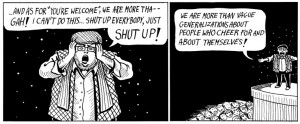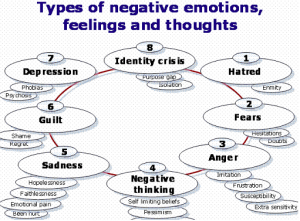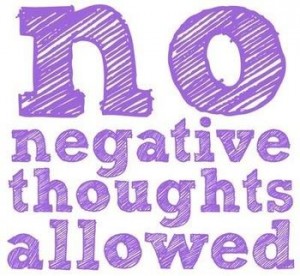Exploring Your Unhelpful Thoughts

Whenever you experience any kind of emotion, this emotion is always accompanied by a set of thoughts. These thoughts are constructed of words and statements that often manifest in the form of questions. You ask these questions in order to make sense of your emotions and your circumstances. If you ask the right kinds of questions, you will get the right kinds of answers that will help you move forward in a positive way. However, if you ask the wrong questions, then you will often end up creating additional problems for yourself.
This is in a ways a very simplified explanation of our thought-process. This is how we think and how we respond to circumstances. When we choose to think in optimal ways, we can often get the best out of our abilities. However, when we think in limiting ways we often end up making the situation far worse than it should be. You therefore have both helpful and unhelpful thoughts that direct your behaviors, decisions and actions throughout the day.
For the purpose of this discussion we will explore your unhelpful thoughts. These unhelpful thoughts often manifest from unhelpful emotions such as anger, anxiety, stress, depression, fear, etc. You experience an unhelpful emotion, which is preceded by a number of unhelpful thoughts or statements you make to yourself. These unhelpful thoughts have certain characteristics and patterns in the way they tend to manifest in your life. These “thinking” patterns are known as “unhelpful thinking styles”.
Unhelpful thinking styles are built upon automatic habitual patterns that you pick-up over a lifetime. These thinking styles become rather problematic when you consider the fact that they direct your behavior at an unconscious level of awareness. Therefore if you’re in the habit of using some of these unhelpful thinking styles on a consistent basis, then you can be assured that you are not living up to your full potential.
These thoughts are not helpful. They are not making your life any easier, and they are certainly not empowering you whatsoever. The unhelpful thinking styles you have chosen to use and adopt are limiting your perspectives, denying you opportunities, creating additional problems, and making you feel absolutely miserable. Isn’t it time you put a stop to them once and for all?
Ten Common Unhelpful Thinking Styles
There are ten recognized unhelpful thinking styles that you might typically indulge in. All styles are equal, however some will of course be more problematic than others depending on how you use them and depending on what you are trying to accomplish.
As you go through each of these unhelpful thinking styles you might recognize some similarities between them. Some of them are in fact very similar in nature. However, they will tend to manifest in your life in a slightly different way. The purpose is therefore to identify the patterns, and how these patterns of thinking tend to shape and hinder your view of reality.
Let’s now briefly take a look at each one of these ten unhelpful thinking styles before breaking them down in detail:
Mental Filter

Here you tend to filter things in and out of your conscious awareness. This is a form of “tunnel vision” where you only tend to focus on a part of something and you ignore the rest. You might for instance only filter out all the negatives of a particular situation. You therefore only see the negatives and fail to recognize and acknowledge the positives. Your vision of reality is therefore based on your flawed perspective of the negativity you see in each particular situation.
Jumping to Conclusions
Here you tend to jump to unjustified conclusions. You make quick assumptions about how things are and what they’re going to be like in the future (predictive thinking), or you will assume that you know what someone else is thinking (mind reading). These conclusions and assumptions are not based on fact or evidence, but rather based on your feelings and personal opinions. As such they can often lead you astray down the wrong path.
Personalization

Here you tend to blame yourself for your problems and for everything that goes wrong in your life. You might for instance continuously blame yourself for your misfortunes and bad luck. This will be true whether or not you are responsible or partly responsible for the problem or misfortune. Taking responsibility for things is admirable, however it can end up being a very burdensome habit-of-mind that leads to very strong feelings of guilt and regret.
Black and White Thinking

Here you tend to only see the extremes of a situation. You either see one extreme or another and this is why it’s called black and white thinking. You will for instance either see the good or bad, the right or wrong, the sad or happy, the left or right, etc. And because of your extreme way of viewing things, there is never a middle-ground. As such you are unlikely to view things in an unbiased and neutral way.
Catastrophising
Here you tend to completely blow things out of proportion and make them out to be a lot worse than they should be. The reality of the situation might be quite insignificant and small. However, because you’re in the habit of catastrophising, you always tend to make your problems larger than life — thereby making your problems even more difficult to overcome.
Overgeneralization

Here you tend to reference your past in order to make assumptions about the present. You might for example take one instance from the past and use that as a “predictor” or barometer for a current or future situation. Whenever you use the words “He always… She always… Everyone… You never… People never… I never…” you are at that moment overgeneralizing.
Shoulding and Musting
Here you tend to put unreasonable demands and pressure on yourself and on other people to do certain things. You tend to say, “I must… I should… You must… You should…”. These statements provide insight into the standards you tend to uphold and the things you expect of yourself and others. These standards can of course at times be helpful, however at other times “shoulding” and “musting” can create unrealistic expectations that you or others will struggle to live up to.
Labeling

Here you tend to label yourself or other people in certain ways based on behavior in very specific situations. These labels you make form your belief systems. Therefore the more times you use these labels the stronger your beliefs become. This can be a good thing, however it’s unhelpful when you tend to label things a certain way despite the facts and evidence that are inconsistent with the labels you are making.
Magnification and Minimization

Here you tend to magnify the positives attributes of another person, while at the same time minimizing your own positive attributes. You are essentially devaluing yourself — bringing yourself down — while raising the stature of other people. In this scenario you tend to explain-away everything you have going for yourself including your positive traits, characteristics and achievements as though they don’t matter.
Emotional Reasoning
Here you tend to base your view of a particular situation in accordance with how you’re feeling. Therefore your feelings dictate how you perceive a situation despite evidence to the contrary. As such you might choose to feel bad about something that is going to happen just because you are feeling miserable in the moment. You are therefore using your current emotional state as a barometer that directs how you will view your life and circumstances.
Within the following sections we will explore each of the ten unhelpful thinking styles in a little more detail. As you work through each section you will come across a set of self-analysis questions. These questions are designed to help you identify how, where and why you might be using some of these unhelpful thinking styles.
With a greater understanding of your habitual thinking patterns, comes a greater sense of control that will help encourage positive change in your life.
Mental Filter

Mental filtering is the process of filtering information in and out of conscious awareness. As this is happening you tend to only focus on very specific things while ignoring everything else. This often involves filtering out all the positives and only bringing into conscious awareness all the negatives of a situation. As a result you tend to focus excessively on problems and on negative events and consequences. On the flip-side you tend to ignore the positives and the opportunities you are presented with.
You might for instance be in the habit of focusing on the small and insignificant details of a situation. These details might be of a negative nature. However, they are insignificant, and therefore focusing on these things just doesn’t make any sense. But you focus on them anyways because you tend to gain some value and benefit from complaining and/or pointing out the negatives. You are so caught up in this way of thinking that you don’t even consider other possibilities that might be more favorable and positive. And as a result you feel absolutely miserable.
Mental filtering also occurs when you reflect on your past experiences. You might for instance have all these wonderful memories of past events and circumstances. However, at the moment you are not in a healthy state-of-mind, and as a result you only tend to recall the negative and hurtful experiences from your past. This is actually how a person suffering from depression might think. Likewise when you feel disappointed, angry, hurt, or when experiencing low self-esteem — this too is a clear indication of mental filtering.
Exploratory Questions
Have a think about your thoughts for a moment and consider how you tend to use your mental filter. Ask yourself:
When do I tend to use a negative mental filter?
In what specific situations do I use it?
How do I think at the time? Why do I think this way?
What do I say to myself?
How does this make me feel?
Why do I tend to filter things in this way? Do I gain some value from it?
Your key objective here is to get a clear understanding of how you tend to use mental filters throughout your life. Awareness is the first step to change.
Solution Oriented Questions
To overcome this unhelpful thinking style it’s important to look for the silver-lining in every situation. Make an effort to find more positives than negatives. Focus on the positives and you will successfully shift how you think about the situation. You might find it helpful to ask yourself:
Am I seeing the full picture here? Is there anything missing?
What would other people see in this situation? How would they interpret things?
What is the silver-lining here?
What’s positive about this situation that I hadn’t noticed?
How do the positives outweigh the negatives here?
Why is it of value to view this situation in a positive light?
Jumping to Conclusions

Jumping to conclusions means you are assuming that something will be a certain way or is a certain way without having the necessary facts or evidence to back-up your assumptions. This is not the same as having an inkling about something. It’s rather about prematurely judging a situation before you have the necessary supportive information to back-up the conclusions you are making. This is especially unhelpful if you are making negative conclusions about people, events or circumstances in your life.
You might for instance make negative assumptions about what will happen in the future if you make a particular decision. These assumptions may direct your mind away from opportunities you could have potentially taken advantage of before making your conclusions. Or in another instance you might make negative assumptions about people’s intentions. Misreading people in such a way might cause unnecessary friction in your relationships.
We often tend to jump to conclusions in two specific ways. The first is through mind reading, and the second is through predictive thinking. Let’s look at each of them in a little detail:
Mind Reading
Here you are assuming that you know what someone else is thinking or the rationale behind their behavior. Your partner might for instance send you a text message that he/she wants to have a very important chat with you when you get home. Immediately alarm bells start ringing and you jump to quick conclusions about what this could really mean. Do they want to break up with me? Have they cheated on me? Have they lost their job? etc.
In another instance, you might be chatting with someone who is constantly shuffling their feet. They appear restless and agitated and you immediately jump to the conclusion that they are not interested in talking with you. Maybe they find you a bit boring. However, little do you realize that they’ve been standing on their feet all day and their legs are absolutely exhausted.
Another example might be of a friend passing you by on the street without saying “hello”. You immediately jump to the conclusion that they are holding some kind of grudge against you. However, they simply didn’t see you. Or how about one of your flat-mates coming back from work one evening. You try and have a conversation with them, however they seem very spiteful and angry. You jump to the conclusion that they are angry at you, and you begin to question what you did to upset them. Little do you realize that earlier that day they received some terrible news about one of their family members.
Jumping to these kinds of conclusions isn’t helpful because you end up stressing about things unnecessarily. These conclusions do however provide you with important insights into your own insecurities. You are for instance jumping to conclusions that your partner wants to end the relationship because you simply don’t feel as though you deserve to be with them. Or you jump to conclusions that other people find you boring because you actually believe that you are a boring person. You therefore label yourself as being “boring” and you use this filter when trying to make sense of other people’s behavior. This is certainly not helpful, and will often cause you a great deal of unnecessary anguish.
Predictive Thinking
Here you are making predictions about something negative that will happen sometime in the future. You are putting so much weight on the negatives of the situation that you end up experiencing a lot of unnecessary stress and anxiety.
You might for instance need to do a presentation for an upcoming corporate function. This is the first time you are going to be doing a presentation of this nature, and as a result you are feeling uncertain and nervous. You start jumping to all these conclusions about what will go wrong, despite the fact that you are quite a competent presenter. Thinking about this makes you feel terrible and puts extra (unnecessary) pressure on you to perform.
Exploratory Questions
Have a think about your thoughts for a moment and consider how you tend to jump to conclusions. Ask yourself:
How do I tend to jump to quick conclusions?
When do I indulge in mind reading?
When do I indulge in predictive thinking?
In what specific situations do I jump to these sorts of conclusions?
What evidence and facts do I tend to often overlook?
How do I think at the time? Why do I think this way?
What do I say to myself?
How does all this make me feel?
Why do I tend to jump to conclusions? Do I gain some value from it?
Your key objective here is to get a clear understanding of how you tend to jump to conclusions throughout your day. Awareness is the first step to change.
Solution Oriented Questions
To overcome the habit of mind reading, it’s important that you first let go of needing to win the approval of other people. You won’t be able to please everyone every single time. People will also not always be agreeable with you. That’s life, and you must accept that. On the flip-side, expect the best intentions from people unless you have solid evidence that proves otherwise. Keeping an open mind and being receptive to new ideas and perspectives will put you in good frame-of-mind moving forward. To help you with this process ask yourself:
How do I know this is true? Where is the concrete evidence?
How could I test my thoughts about this?
What if things are not what they seem on the surface?
What if there is another explanation for this behavior?
What if things are the way I imagine them? Why should this bother me?
Am I any lesser of a person as a result of this person’s behavior or opinion?
How could this experience be empowering? How could it be an opportunity?
To overcome the habit of predictive thinking, you must always question the predictions you are making. For instance, ask yourself:
Does worrying about this protect me or prepare me? Is this helpful?
How do I know things will turn out this way?
How many times have I made incorrect predictions?
What evidence do I have that supports this prediction?
How have I arrived at this understanding?
How could thinking this way potentially hurt me in the long-run?
What’s the evidence against this way of thinking about things?
What if my predictions are true? How could I best handle things?
What is the worst, best and most likely outcome?
What’s a positive outcome that could result? How could I ensure this happens?
Personalization

Personalization is a form of self-inflicted guilt that can often lead to shame and the feelings of inadequacy. It is when something unfortunate happens that you tend to blame yourself for. So for instance, let’s say you invite one of your friends out for a hiking trip up a mountain. During the hike they fall and sprain their ankle. You now blame yourself for inviting them.
Here’s another example: Let’s say you buy some milk at the supermarket that’s past its use-by date. Instead of blaming the supermarket for selling you the milk, you blame yourself for not checking the use-by date on the bottle. Or let’s say that your son or daughter makes a big blunder while playing for their school basketball team, and this consequently costs them the game. When you personalize things, you end up blaming yourself for not coaching them better.
This isn’t about taking responsibility, it’s rather about taking the blame for things that are often not entirely within your direct control. Yes, of course life is about taking responsibility for your choices, decisions and actions. However, taking responsibility for every negative thing that isn’t fully within your control is a very self-defeating behavior. You are taking responsibility on the one hand, however on the other hand you are ignoring other very important factors. As a result you end up blaming yourself for everything that went wrong or that could go wrong. This has a tendency to deflate your self-esteem while making you feel discouraged and miserable.
Be responsible for your life. Be responsible for the many roles you play. Be responsible for your thoughts. Be responsible for your choices and decisions, however at the same time keep in mind that not everything is your fault, or your responsibility. You’re not to blame for all the negative things in your life. You’re also not to blame for other people’s failures and mistakes. Sometimes things are simply out of your control. You must accept and live with that.
Life will not always be rosy, and negative things will happen. Sometimes things will be your fault, however other times there will be nothing or no one to blame. It’s just how things are. It’s how life is. You take what is, then you make the best of every situation, and you move on from there.
Exploratory Questions
Have a think about your thoughts for a moment and consider how you tend to personalize things. Ask yourself:
How do I tend to personalize things?
In what specific situations do I tend to do this?
How do I think at the time? Why do I think this way?
What do I say to myself?
How does personalizing things make me feel?
Why do I tend to personalize things? Do I gain some value from it?
Your key objective here is to get a clear understanding of how you tend to personalize things throughout your day. Awareness is the first step to change.
Solution Oriented Questions
To overcome this unhelpful thinking style it’s important to pinpoint the cause of your problem. Therefore instead of blaming yourself for things that are out of your control and consequently feeling guilty about it, choose instead to solve the problem that is being presented before you.
It’s also important to distinguish between self-criticism and self-correction. The key is not to blame or criticize yourself, but rather to learn and grow from this experience in order to make the necessary corrections for the future. You might therefore find it helpful to ask yourself:
How do I know I am to blame for this?
Is it realistic to blame myself for what just happened?
How much of this was really under my direct control? [search for evidence.]
Who or what else could have created this problem?
How much of this problem am I actually responsible for? What part specifically?
What is the specific cause of this problem?
How could I go about solving this problem?
What were the intentions of all the people involved?
To what extent was this outcome due to causes that were completely out of everyone’s control?
What if there is no one or nothing to blame for this problem? What then? How do I feel about this?
How could I help resolve future instances of this problem?
Black and White Thinking
Black and white thinking is a form of all-or-nothing thinking. Here you are only seeing one extreme or another. There are no in-betweens, and there are certainly no shades of gray. Things are either this way or they are that way. There is nothing in between and you will not accept any other explanation.
You might for instance have some extreme expectations of yourself that you will never make any mistakes when doing something specific. However, when you eventually do make a mistake, you view yourself as a complete and utter failure. Or let’s say for instance that you have an argument with a co-worker. As a result of this argument you think to yourself that if you guys can’t agree then you shouldn’t be working together. Or how about you fail to make a sale during a particular week, and immediately you think to yourself that you are just not good at sales.
Thinking this way is very detrimental because it immediately makes you feel inadequate and worthless. The reality is that “absolutes” do not exist. However, if you constantly see your world in “absolutes” then you will always feel worthless because you simply won’t be able to live up to your lofty and exaggerated expectations.
Exploratory Questions
Have a think about your thoughts for a moment and consider how you tend indulge in black and white thinking. Ask yourself:
How do I tend to indulge in black and white thinking?
In what specific situations do I tend to do this?
How do I think at the time? Why do I think this way?
What do I tend to say to myself?
How does indulging in black and white thinking make me feel?
Why do I indulge in black and white thinking? Do I gain some value from it?
Your key objective here is to get a clear understanding of how you tend to indulge in black and white thinking throughout your day. Awareness is the first step to change.
It’s important to remind yourself that nothing is 100 percent like this or like that. No one is all bad or all good, and life is not just about the winner and loser. There are many different levels, grades or shades of experience that will help enrich your life in so many incredible ways. Sometimes things are “that way”, and sometimes they are “this way”. However, other times they are different. There are therefore always exceptions to the rule.
Solution Oriented Questions
To overcome the habit of black and white thinking, ask yourself:
Does thinking this way tend to motivate me? Why?
Is thinking this way realistic and helpful?
Has there ever been a time in the past when things were not this way but rather another way?
What are the exceptions to this rule?
What is the evidence that disproves how I’m viewing this situation?
How could I prove that my thoughts are wrong about this?
What could be worse than this? What could be better?
Would everyone see things as I see things? Why? Why not?
Really, never? Does this make any sense at all?
Really, always? Does this make any sense at all?
Catastrophising

Catastrophising is when you have a tendency to blow things out of proportion unnecessarily — exaggerating the importance of your errors, fears and imperfections. You essentially live through Murphy’s Law and turn mild pessimism into an absolute nightmare.
You might for instance experience a minor setback, however because you’re in the habit of catastrophising, you will turn the problem into a big, awful and insurmountable obstacle that you will never overcome. Or you might have a chest pain and immediately you think to yourself that it’s a heart attack. Or, you have a slight disagreement with your partner and you immediately think that this argument will end your relationship. Or for instance you think you might have left the kitchen stove on, and you are already imagining your house burning down in rubbles.
Here’s another example: Let’s say you can’t find your wallet, and immediately you imagine that someone has stolen it and is now emptying your bank accounts. As a result you won’t be able to pay your bills. And if you can’t pay your bills the bank will repossess your car. And if you don’t have a car you can’t travel to work, and you will therefore lose your job. As a result you will be forced to sell your home to pay all your debts. Then you’ll end up living on the street begging for food. And it’s the middle of winter. It will be cold and you will fall ill and end up in a hospital bed. And then… ![]()
When you’re catastrophising you are creating worst-case scenarios in your head out of small and relatively insignificant things. You are creating problems where there are no problems. What’s worse, is that you are over exaggerating these problems in unrealistic ways.
You might have a tendency to catastrophise in order to make yourself feel important, to win the sympathy of other people, or simply because you want to add more excitement to your life. There might actually be quite a number of reasons why you might indulge in catastrophising. However, the reasons don’t matter. What matters is that catastrophising can lead to significant “phantom” problems (only real in your imagination) that slowly but surely take over your entire life. They aren’t real, but they feel real and soon things become overwhelming and you quickly lose control.
Exploratory Questions
Have a think about your thoughts for a moment and consider how you tend to indulge in catastrophising. Ask yourself:
How do I tend to catastrophise things?
When do I tend to do this?
How do I think at the time? Why do I think this way?
What do I tend to say to myself?
How does catastrophising make me feel?
Why do I tend to catastrophise things? Do I gain some value from it?
Your key objective here is to get a clear understanding of how you tend to catastrophise things throughout your day. Awareness is the first step to change.
Solution Oriented Questions
To overcome this unhelpful thinking style, it’s important that you continuously question the problems/things that you are blowing out of proportion. Ask yourself:
Does worrying about this protect me? Does it prepare me? Is this necessary?
Thinking realistically about this, how likely is this to happen?
What evidence is there that supports my catastrophic thoughts?
What evidence and facts do I have that this is unlikely to happen?
What if things aren’t as I make them out to be?
What if the opposite of what I’m catastrophising is more likely to happen?
How many times before have I made incorrect predictions?
What if this isn’t a problem to begin with? What if this is only a “phantom” problem?
What if my thoughts about this are true?
What would specifically have to happen to make this a reality?
What are the actual realistic chances of this happening in exactly this way?
If things happen this way, how will I feel about it next week? Next month? Next year?
How could I best prepare myself to handle the worst-case scenario?
What positives could potentially result from this experience? Could there be any opportunities here?
How would others see things differently then I have been imagining them?
Overgeneralization

Overgeneralization involves taking a single piece of evidence or single isolated cases, and then imposing them on all current or future scenarios. In other words, if something happens to you once then it will probably continue to happen to you over and over again. You might for instance recall one particular incident in your past and as a result you end up making the following statement:
Nothing ever works out for me. I never have any luck. I am doomed to fail…
Here you are justifying how you’re feeling about the present based on one particular incident in the past. This is helpful if you’re using it as a means of learning from past mistakes or experience. However it becomes problematic when you ignore all other instances when things actually did go your way and you ended up succeeding.
Here are some other examples:
You always do this…
Everyone’s always like that…
I never get my way…
Things always end up disastrous for me…
Making these broad conclusions about how things will be in the present based on very little evidence in the past can leave you feeling as though you have no control over your life. You end up feeling helpless and disheartened that your life doesn’t rest in your hands.
Exploratory Questions
Have a think about your thoughts for a moment and consider how you tend to overgeneralize things. Ask yourself:
How do I tend to overgeneralize things?
When do I tend to do this?
How do I think at the time? Why do I think this way?
What do I tend to say to myself?
How does overgeneralizing make me feel?
Why do I tend to overgeneralize things? Do I gain some value from it?
Your key objective here is to get a clear understanding of how you tend to overgeneralize things throughout your day. Awareness is the first step to change.
Solution Oriented Questions
To overcome this unhelpful thinking style, it’s important that you get out of the habit of building your entire future around isolated negative events or instances from your past. It’s also helpful to avoid using words such as “always” and “never”. Ask yourself:
Am I being realistic when I’m overgeneralizing things?
What evidence do I have that suggests things will always be this way and not another way?
Just because someone has acted like this before, does it mean that they will always act this way?
How else could things be? What are the possibilities? What have I failed to consider?
What other instances from the past suggest that things could be different then I expect them to be in the present?
Would other people make the same overgeneralizations I am making in this situation? Why? Why not?
What if I overgeneralized things the opposite way? Instead of focusing on one negative, what if I focused on one positive and used this to predict future scenarios?
Shoulding and Musting

This involves using common statements that start with “I should…” or “I must…”. These statements are only unhelpful when you begin putting unreasonable demands and pressures on yourself or others.
These kinds of statements often stem from a list of ironclad rules that you have about yourself and about other people. These rules dictate how you will behave, and how you expect others to behave in different situations. When these rules are violated you end up feeling disappointed and angry.
Thinking that you “should always” get things right, or that you “should always” exercise, or that “you must” not make a mistake can put undue pressure on you to perform to your own personal expectations. And when you don’t reach your expectations you end up feeling disappointed and disheartened. Moreover, you might even end up feeling guilty that you let yourself down.
These kinds of statements can also be used while talking about other people. You might for instance expect that your friend “should” do such-and-such, or that they “must always” keep their promises.
It’s fantastic to have positive expectations about yourself and about others; however are these expectations realistic? And, are they realistic in all situations? Maybe you’re making unreasonable demands. And if you are, then that leaves you open to disappointment, anger and frustration. Moreover, directing these statements at other people can create a lot of resentment and turmoil within your relationships.
Exploratory Questions
Have a think about your thoughts for a moment and consider how you tend to use “shoulding” and “musting”. Ask yourself:
What kinds of “should” and “must” statements do I tend to make?
When do I tend to do this?
What unreasonable demands do I put on myself?
What unreasonable expectations do I put on other people?
How do I think at the time? Why do I think this way?
What do I tend to say to myself?
How does thinking in this way make me feel?
Why do I have these kinds of expectations?
Your key objective here is to get a clear understanding of how you tend to use “should” and “must” statements throughout your day. Awareness is the first step to change.
Solution Oriented Questions
To overcome this unhelpful thinking style, it’s important that you continuously question the validity of whether or not you or someone else “should” or “must” do something. Ask yourself:
Does thinking this way help motivate me? Or does it end up deflating me?
How is trying to motivate myself in this way unhelpful?
Does being strict and demanding help motivate others?
Is this the way it is, or do I actually have a choice?
How would other people view this? What would they say?
What if I didn’t do this? What would happen?
What if I chose to do something else instead? What then?
What’s preventing me from doing this now?
What rule says that I must do this?
What rule says that someone else must do this?
Do I make these demands on others as a form of criticism or judgment? Why?
Do I make these demands on some people and not on others? Why?
What if I used the words “I choose to” or “I would prefer to”. How would that change how I think about things?
Why should I do this? What if I didn’t?
Why must I do this? What if I don’t?
Why should they do this? What if they didn’t?
Why must they do this? What if they don’t?
What other options are there?
Labeling

Labeling involves making global statements and/or generalizations about yourself or about others that are based upon behavior in very specific situations. Therefore instead of describing the specific behavior and taking it in isolation, you choose to create labels that are negative and absolute. In such instances, it’s not about the behavior in the moment, it’s rather about making judgments about all future behavior based on what you have just observed. You might for instance catch yourself saying:
I’m such an idiot… Instead of: I made a mistake…
She is so unreliable… Instead of: She let me down today…
He is such a jerk… Instead of: He messed up today…
When you label yourself, you are at that very moment creating a negative and flawed self-image based on your personal errors. This self-image influences your self-esteem, and your self-esteem affects the choices and decisions you make or fail to make. Therefore labeling yourself in negative and limiting ways based on any “one thing” you do, can have a very significant impact on your life. It’s irrational and wrong. You are not “any one” thing you do. Your life is an ever-changing flow of thoughts and emotions that provide you with endless possibilities and opportunities for growth and development.
Labeling yourself or defining others based on one particular instance of their behavior is never helpful because it doesn’t take other instances of this behavior into consideration. You might for instance call yourself “stupid” when you make a mistake. However, this doesn’t mean you are actually “stupid”. You might have a lot of knowledge, have a college degree, and have a very successful career. However, labeling yourself as “stupid” tends to cross all boundaries and filter though to other areas of your life. Let’s say for instance something happens at work, and again you call yourself “stupid”. Then you drop a plate full of food onto your brand new carpet at home, and again you call yourself “stupid”. Then over time something happens. The more you label yourself as being “stupid”, the more you believe it, and the more you believe it, the more “stupid” things you tend to do, and this filters through your entire life.
A single incident doesn’t define who you are. Likewise, a single incident, action, or behavior doesn’t define who other people are. For this reason, it’s important to be very careful of the labels you make throughout your day. Don’t go making unjustified global statements about yourself or others that are based upon specific situations.
Exploratory Questions
Have a think about your thoughts for a moment and consider how you tend to label yourself and other people. Ask yourself:
How do I tend to label myself?
How do I tend to label other people?
How do I think at the time? Why do I think this way?
What do I tend to say to myself?
How does thinking in this way make me feel?
Why do I tend to make these sorts of labels?
Your key objective here is to get a clear understanding of how you tend to label yourself and other people. Awareness is the first step to change.
Solution Oriented Questions
To overcome this unhelpful thinking style, it’s important that you get out of the habit of making global statements about behaviors in isolation without taking into consideration the context of the situation or other instances that aren’t congruent with this behavior. Ask yourself:
Is this label true in all situations?
Am I labeling this specific behavior, or am I labeling the whole person? How is this of significance?
What evidence is there that proves that this label is correct?
What evidence is there that disproves this label I just made?
What other situations and/or behaviors disprove this label?
What’s the opposite of the label I am making? How might this be true?
Would other people create the same labels? Why? Why not?
Magnification and Minimization (discounting positives)
This unhelpful thinking style involves magnifying the positive attributes of other people, while at the same time minimizing your own personal attributes. In other words, you are exaggerating your own “negatives” (weaknesses) while at the same time understating your own “positives” (strengths). Likewise, you tend to exaggerate the positive characteristics of other people while understating their negatives. For instance, you might say:
They don’t really mean it. They were just being nice…
Oh, I wouldn’t be able to do what you did once again. I just got lucky…
This is not about ignoring positive attributes or experiences, but rather about turning positives into negatives that affect your state-of-mind in very limiting ways.
Here you have an inability to accept anything positive in your life, and will instead go out of your way to turn these events into something that’s negative and unhelpful. The more you dwell on the negatives, the less you are able to appreciate the good things in your life.
There’s of course nothing wrong with being humble. However, it’s certainly not healthy if you end up turning your own positive experiences into something negative (like in the above examples). Putting yourself down and completely disqualifying your own attributes is not healthy and can significantly affect your self-esteem in the long-run. Continued poor self-esteem can lead to feelings of inadequacy, which can eventually lead down the path to depression.
Exploratory Questions
Have a think about your thoughts for a moment and consider how you tend to magnify and minimize things. Ask yourself:
How do I tend to magnify the positive attributes and experiences of other people?
How do I tend to minimize my own positive attributes and experiences?
How do I twist my own positive attributes and experiences in a negative way?
How do I think at the time? Why do I think this way?
What do I tend to say to myself?
How does thinking in this way make me feel?
Why do I tend to indulge in this way of thinking?
Your key objective here is to get a clear understanding of how you tend to magnify other people’s attributes while also minimizing your own personal attributes. Awareness is the first step to change.
Solution Oriented Questions
To overcome this unhelpful thinking style, you will need to begin focusing more on giving yourself the credit and the praise you deserve for your strengths and achievements. Begin by asking yourself:
Why do I feel it’s important to minimize the positives in this situation? Why specifically do I do this?
What are the consequences of this way of thinking about things?
What assumptions am I making about myself, others, or about this situation?
How are my assumptions preventing me from seeing the truth? How is this hurting me?
How could it be of value to magnify the positives of this situation? How would that make me feel?
What if the other person did mean what they said? What evidence is there that proves this is true?
What if I deserved to be complimented? What evidence is there that proves this is true?
What if I deserved the results I attained? What evidence is there that proves this is true?
What if it wasn’t luck but rather a combination of knowledge, experience and talent? Where is the evidence for this?
What if I believed that I was deserving and capable? How would I subsequently magnify things?
Would other people discount the positives in such a way as I do? Why? Why not?
Emotional Reasoning

Emotional reasoning involves making decisions based on how you feel rather than on objective reality. You are therefore basing your view of a situation, yourself, or of others in ways that mirror your feelings. In other words, your current emotional state influences how you perceive a situation despite evidence to the contrary.
You automatically tend to believe that what you’re feeling is the truth. However, it’s only true for you, and the feelings that someone else experiences might be very different. And it’s these differences that determine how you perceive a situation, what decisions you make, and what actions you inevitably take.
You might for instance be feeling guilty, which signifies that you might have done something wrong or hurtful. In another situation you might be feeling overwhelmed and disheartened, which signifies that you are not capable of solving your problems. Or let’s say for instance that you are feeling depressed, which signifies that this is going to be another hopeless day. Or, how about you are just feeling lousy, and therefore you won’t clean your house because it seems too difficult. Or, you’re feeling anxious, and that obviously means that something bad is going to happen.
In these instances, you are “feeling” a certain way, and that means that your life “is” a certain way that matches that particular emotion you are experiencing. You are allowing your emotional experiences and feelings to guide your daily choices and decisions. And this is hurting you because sometimes you might not feel like doing something, however with a little “push” you can certainly motivate yourself to do that “thing”. However, as long as you continue to allow your emotions to dictate your behavior, then you will continue to fall prey to your limiting habitual thinking patterns.
Exploratory Questions
Have a think about your thoughts for a moment and consider how you tend to use emotional reasoning throughout the day. Ask yourself:
How do I tend to make decisions based on my emotions and feelings?
How do I tend to predict the future using emotional reasoning?
How do I tend to make judgments using emotional reasoning?
When do I tend to do this?
How do I think at the time? Why do I think that way?
What do I tend to say to myself?
How does thinking this way make me feel?
Why do I tend to indulge in emotional reasoning?
Solution Oriented Questions
To overcome this unhelpful thinking style, you will need begin consciously distinguishing between an emotion and a fact. Ask yourself:
Am I basing my interpretation of this experience on my emotions or on the facts of the situation?
What are the facts of this situation? What specifically can I see and hear? Why is this important?’
What evidence suggests that the way I’m thinking about this is not accurate?
How are other people interpreting this experience? Are their interpretations based on feeling or fact?
How accurate is it to use emotional reasoning to predict the future? When have I been right? When have I been wrong?
Is it valuable to use emotional reasoning to make judgments about things? About others? About myself?
Given what I now know, have my emotions guided me well? Or have they hurt me?
Challenging Your Unhelpful Thoughts

Within the previous section you challenged each of your unhelpful thoughts individually using a set of specific questions. Within this section we will look at how to challenge all your unhelpful thoughts using one questioning approach that also takes into account limiting beliefs associated with that thought. You can therefore use this process to help you successfully challenge the unhelpful thinking styles that might be prevalent in your life.
As you work through these questions, keep in mind that indulging in unhelpful thinking patterns directly influences the emotions you experience on a daily basis. These emotions likewise influence how you perceive reality. And this likewise influences the choices you make, the behaviors you indulge in, and the actions you take, which ultimately influences the outcomes you are likely to realize in your life. Therefore by continually indulging in unhelpful thinking patterns you are doing nothing but maintaining the status quo. Nothing changes, nothing improves, and your life stagnates. You feel stuck in your old limiting patterns of behavior, and you feel helpless to do anything about it.
To change, you will need to reprogram your brain. And reprogramming your brain means making a conscious effort to break out of all the unhelpful thinking patterns that are currently prevalent in your life. A task of this magnitude requires a shift in thinking. And this shift only comes about when you begin challenging your unhelpful thoughts and their associating beliefs. You must essentially become a detective, which requires an assessment of whether or not your thoughts and beliefs are helpful and aligned with the outcomes that you would like to achieve.
Transforming your thoughts requires identifying all the facts and the evidence that will help you to resolve these unhelpful thinking patterns. Once you have a clear view of the situation, your next step will be to challenge these thoughts as a lawyer would in a courtroom. However, before you even reach that stage, your very first task will be to recognize these unhelpful thinking patterns as they come into conscious awareness.
Recognizing Unhelpful Thoughts
Your unhelpful thoughts are often accompanied by strong and sudden shifts in how you’re feeling. The moment you recognize one of these shifts, immediately try to pinpoint what triggered this feeling. Ask yourself:
What am I feeling at the moment?
What specifically triggered this feeling? Why?
How am I thinking about this situation?
What exactly am I saying to myself?
How is what I’m thinking and saying influencing how I’m feeling?
What underlying limiting beliefs might be causing me to feel this way?
Often accompanying an unhelpful thought and an uncomfortable feeling is a limiting belief that influences your perspective of the situation. When you successfully challenge your unhelpful thought, you effectively weaken the hold that this limiting belief has over your life. To do this, take time to work through the following six step process that will help you to successfully challenge your limiting thought patterns.
Step 1: Understand Your Outcomes
Your very first step is to identify the outcomes that you would like to achieve. Without knowing your outcomes, and without understanding the reasons why you are wanting to achieve these outcomes, you will find it very difficult to make positive and lasting change. Ask yourself:
What specific outcomes would I like to achieve?
Why do I want to achieve these things?
Why specifically do I want to change? [thoughts or beliefs]
What will changing allow me to do?
What will changing allow me to have?
What will changing allow me to experience?
What kind of person would I like to become as a result of making these changes?
Why do I want to become this person? What genuine reasons do I have?
Why do I want to achieve these goals?
Step 2: Unlock Your Motivation
Having now gained some clarity about what it is you want and why you might want it, your next step is to create the necessary motivation you need to follow through with this change. This requires activating the pain and pleasure principle.
First let’s associate some pleasure to making these positive changes in your life. Ask yourself:
What will I gain by making these changes?
What are the benefits of achieving my desired outcomes?
What will achieving this allow me to do?
What are the benefits in the short-term?
What are the benefits in the long-term?
How will all this make me feel?
Now, let’s associate some pain. This is the pain that you will experience if you are unable to successfully make these changes. Ask yourself:
What will I lose by not making these changes?
What are the negative consequences of not achieving my desired outcomes?
What are the short-term consequences of holding onto my unhelpful thoughts?
What are the long-term consequences of holding onto my unhelpful thoughts?
What will I not be able to do, be, have, and experience as a result of not making these changes?
How will all this make me feel?
Having gone through this process, you should now feel more motivated and inspired to take positive action in the direction of your desired outcomes.
Step 3: Do Your Detective Work
It’s now time to gather the necessary facts, proof and evidence that you need to help you build a case against your unhelpful thoughts. Take for instance one of the unhelpful thoughts you identified within the previous section and ask yourself the following set of questions:
What evidence, facts and proof do I have that my thoughts, beliefs, assumptions and/or expectations are true?
How valid are these facts? Do they have any basis in reality? How do I know they are true?
Do I have any evidence that might disprove these thoughts, beliefs and/or assumptions?
Are there any facts or other pieces of evidence that I might have overlooked?
Given my desired outcomes, how realistic are my thoughts, beliefs, assumptions and/or expectations?
How likely am I to achieve my desired outcomes?
Your objective here is to build a case against your unhelpful thoughts. You must collect enough evidence, proof and facts that will effectively disprove the validity of your unhelpful thoughts.
Step 4: Challenge Your Unhelpful Thoughts
Now comes time to challenge your unhelpful thoughts. However, it is important that you remain objective at all times. This is not about what you prefer, or whether or not something is acceptable. It is rather about what makes more sense based on your assessment and evaluation process.
To challenge your thoughts, ask yourself:
How else could I think about this situation? What other possibilities are there?
How might other people think about this situation? What would their perspective be?
How might I view this situation in another context?
How might I view this situation if I was in a different state-of-mind? [experiencing a different emotion]
What’s another way of viewing this situation that I haven’t yet considered?
At the conclusion of this questioning process you should have thrown enough doubt onto your unhelpful thought/belief that it no longer has a stranglehold over your life.
Step 5: Replace Your Unhelpful Thoughts
Your next step is to find a new thought that is more balanced and helpful that will replace your old unhelpful thought. It’s important that this new thought is realistic and aligned with the evidence you highlighted in Step 3 of this process. In other words, your new thought must be based on solid facts and proof that will help support this new way of thinking. In addition to this, your new thought must also be aligned with the outcomes you identified in Step 1 of this process.
To help you identify this new thought, ask yourself:
What’s a new thought I could use that is more helpful and balanced?
Is this new thought consistent with the evidence, facts and proof I identified earlier?
Is this new thought aligned with the outcomes I would like to achieve?
How does this new thought feel? Is it the right thought, or is there something better?
Work back and forth through these questions until the thought you have chosen feels right.
Step 6: Moving Forward
Your final step of this process is to lay down a strong path moving forward towards this desired change. You will for starters need to draw up a plan of action that will help you to clarify in your mind exactly what it is you must do to make these changes. And secondly you will need to ask yourself four scaling questions that will help you figure out whether or not this is the optimal time to make this change.
These four questions are based on your levels of concern, commitment, confidence and motivation. Therefore on a scale of 1 to 10, ask yourself the following set of questions:
Do I have any concerns about making this change?
How committed am I to making this change?
How confident am I that I can make this change successfully?
How motivated am I about making this change?
If you have any concerns about making this change, then you will need to resolve these concerns before moving forward. With the other three questions, you must be at least on an eight out of ten to successfully follow through with this change. You must therefore be fully committed to making this change, which might mean making some difficult sacrifices. You also need to be confident that you can make this change. Without confidence you won’t be decisive enough to follow through with certain actions. And finally, you also need to have the necessary motivation to get you through the difficult moments you are likely to confront along your journey. If you’re lacking in motivation, then you need to find more reasons to make this change. In such cases, it’s helpful to go through the pain and pleasure process once again.
Making these changes will of course take time. These new thoughts must become integrated into your belief systems. For this to happen, you must get into the habit of working with these new thoughts on a daily basis. You must therefore strive to re-train your brain, which will require conscious practice and dedication. Practice of course requires repetition. And repetition requires focus, commitment and motivation.
One way to help you ingrain your new thought-patterns into your psyche is to write down your helpful thoughts on small cards that you carry around in your pocket. That way you will be able to refer to them throughout your day.
Finally, keep in mind that you might very well need to make changes to your life in order to create room for your new helpful thought. This might require changing what you do, or how you do things. It may also require adopting new habits and perspectives. No matter what it is, it has to be congruent with the new thought. Without this congruency you will continuously sabotage yourself by falling back into your old unhelpful thinking patterns.
Working with Core Beliefs
If after going through the process of challenging your unhelpful thoughts, you are still struggling to make positive changes in your life, then this could indicate that you have a set of core beliefs (convictions) that are holding you back. These are often beliefs you have held onto since childhood, which means that they are deeply ingrained into your psyche, and as a result will be very difficult to break.
If this is the case in your situation, then you might find it helpful to work through the following four step process:
Step One
In order to identify your core beliefs, you will need to search for common themes that unlock how you feel about certain things. For instance take the time to conclude the following statements:
- I am… [always feeling helpless.] OR [always making mistakes.]
- People are… [always out to get me.] OR [always rejecting me.]
- The world is… [conspiring against me.] OR [doesn’t give me any opportunity.]
- The future is… [bleak and hopeless.] OR [going to be a struggle.]
In the above example you will notice that in brackets I have concluded each of these statements. Looking at these statements you can probably tell that there is a pattern with how I’m thinking about myself, others, the world, and my future. When you do this exercise, it’s these patterns that will provide you with insight into the core beliefs that might be holding you back from making the changes you desire to instigate in your life. And these are the limiting beliefs you must work through in order to eradicate your unhelpful thoughts.
It is recommended that you complete each of these four statements 20 or more times for a total of 80+ statements. This is important because it will help you to identify patterns in your belief structure that might not have been evident before.
Step Two
Now take the patterns you have identified and piece them together into a related theme of statements that appear most problematic. These are the areas you must focus on in order to pinpoint the underlying core beliefs that are preventing you from moving forward.
Step Three
Your next task is to take one of your statements and identify what it really means to you. Do this by asking yourself:
- What does that mean?
- What does that really mean?
- What’s bad about that?
- What does that say about me?
- What does that mean?
You might for instance take the statement that “People are always rejecting me.” Your answers to these five questions might therefore look something like this:
- It means that I am not very good socially…
- It means that I am shy…
- It’s bad because I don’t have the confidence to talk to people…
- This says that I’m afraid of rejection…
- It means that I’m inadequate. I believe I’m inadequate and just not good enough… [this is your core belief]
In the above example your core belief came to light after five consecutive questions. Use this only as a guide. It may very well take more questions to unlock your core belief. In such an instance, just keep asking these questions over and over again until you unlock that core belief.
Step Four
Your final step is to challenge this core belief. This requires questioning the validity of this belief. You might for instance ask yourself:
What evidence and proof is there that this belief is true?
What experiences have I had that can prove that this belief isn’t entirely true?
Do I have any proof that this belief is simply a figment of my imagination?
